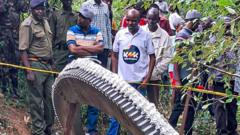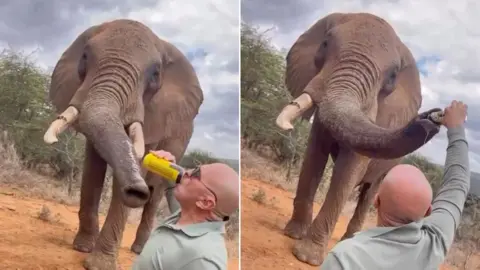In the tranquil village of Mukuku, Kenya, an eerie whizzing sound followed by a thunderous boom caused panic among villagers enjoying a holiday afternoon. “It sounded like a bomb; I was shocked,” recounted Stephen Mangoka, a local farmer. The noise triggered confusion as residents scrambled to see what had caused the disturbance, only to discover a massive, hot metal ring had crash-landed on nearby farmland.
The rural setting soon turned into a makeshift spectacle as villagers gathered to witness the extraordinary sight. "We found a big piece of metal that was very red, so we had to wait for it to cool down before anyone could approach it," said Ann Kanuna, the landowner. After a couple of hours, the metallic ring cooled down enough for people to safely get close, leading to an influx of visitors eager to take selfies alongside the unusual object.
The unexpected visitor weighed over 500 kg (approx. 1,102 lb) and measured about 2.5 m (8 ft) in diameter, similar in size to a children's merry-go-round. As curiosity peaked, local authorities were notified, and the Kenya Space Agency (KSA) prepared to investigate the following day. Concerned about opportunistic scrap dealers, villagers took shifts guarding the metal object, wary of overnight theft.
Upon inspection, the KSA announced that the object was likely a separation ring from a space launch rocket. These components are designed to either burn up upon re-entry or land in uninhabited areas. Luckily, no injuries were reported, although some locals claimed structural damage to their homes from the impact.
"The government needs to find the owners of this object, and get compensation for those affected by it," urged resident Benson Mutuku, expressing fears about possible long-term radiation effects. Initial tests by the Kenya Nuclear Regulatory Authority revealed that while the ring had abnormal radiation levels, they were not harmful to humans.
Experts believe the object could have been part of an Ariane rocket that launched in 2008 and had orbited Earth for 16 years before its sudden descent. The safety concerns raised by this incident highlight the increasing risks posed by space debris, with NASA estimating over 6,000 tonnes of junk hurtling through space.
As the incidents of falling space debris become more frequent, Mukuku’s residents are left anxiously considering what could happen if another piece lands closer to home. “We need assurances from the government that it won't happen again," concluded Mr. Mutuku, reflecting the community's growing concern for safety in an era of expanding space activity.
The rural setting soon turned into a makeshift spectacle as villagers gathered to witness the extraordinary sight. "We found a big piece of metal that was very red, so we had to wait for it to cool down before anyone could approach it," said Ann Kanuna, the landowner. After a couple of hours, the metallic ring cooled down enough for people to safely get close, leading to an influx of visitors eager to take selfies alongside the unusual object.
The unexpected visitor weighed over 500 kg (approx. 1,102 lb) and measured about 2.5 m (8 ft) in diameter, similar in size to a children's merry-go-round. As curiosity peaked, local authorities were notified, and the Kenya Space Agency (KSA) prepared to investigate the following day. Concerned about opportunistic scrap dealers, villagers took shifts guarding the metal object, wary of overnight theft.
Upon inspection, the KSA announced that the object was likely a separation ring from a space launch rocket. These components are designed to either burn up upon re-entry or land in uninhabited areas. Luckily, no injuries were reported, although some locals claimed structural damage to their homes from the impact.
"The government needs to find the owners of this object, and get compensation for those affected by it," urged resident Benson Mutuku, expressing fears about possible long-term radiation effects. Initial tests by the Kenya Nuclear Regulatory Authority revealed that while the ring had abnormal radiation levels, they were not harmful to humans.
Experts believe the object could have been part of an Ariane rocket that launched in 2008 and had orbited Earth for 16 years before its sudden descent. The safety concerns raised by this incident highlight the increasing risks posed by space debris, with NASA estimating over 6,000 tonnes of junk hurtling through space.
As the incidents of falling space debris become more frequent, Mukuku’s residents are left anxiously considering what could happen if another piece lands closer to home. “We need assurances from the government that it won't happen again," concluded Mr. Mutuku, reflecting the community's growing concern for safety in an era of expanding space activity.















